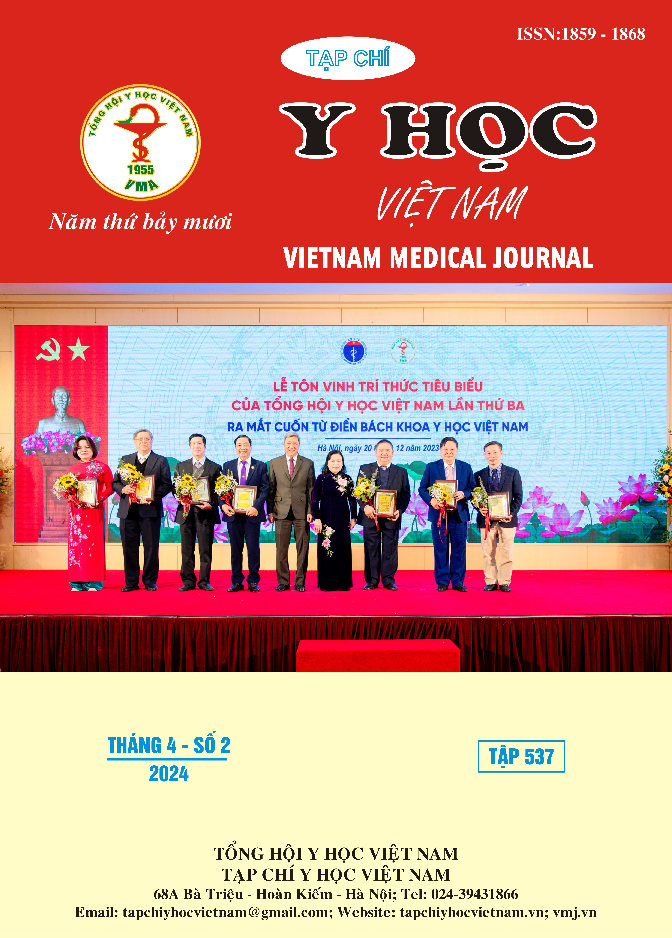APPLYING NESTED MULTIPLEX PCR IN DETERMINING THE CAUSE OF DISEASE AND CHOOSING INITIAL ANTIBIOTICS IN PATIENTS WITH PNEUMONIA AND MECHANICAL VENTILATION
Main Article Content
Abstract
Objective: Describe the results of Nested Multiplex PCR and bacterial culture in determining the cause of pneumonia at the Intensive Care Unit (ICU) in Bach Mai hospital. Method: A prospective descriptive study on 50 patients diagnosed with pneumonia, who was intubated or tracheotomized. These patients were tested for Nested Multiplex PCR and bronchial fluid culture at the same time. Study was carried out from October 2022 to October 2023 at the ICU - Bach Mai Hospital. Results: 50 patients were studied included 33 male patients (66,0%) and 17 female patients (34,0%), average age: 57.24 ± 19.96 years. The leading bacterial causes of pneumonia in ICU are Klebsiella pneumoniae (33.3%), Acinetobacter baumannii (20.0%), and Pseudomonas aeruginosa (16.7%). The rate of antibiotic resistance is increasing over time. The agreement between PCR results and culture was high (68.0%). Semi-quantitative PCR results of 105 or higher have a rate of over 50% of bacterial cultures that match the PCR results. Conclusion: The leading bacterial causes of pneumonia in ICU are Klebsiella pneumoniae, Acinetobacter baumannii and Pseudomonas aeruginosa. The rate of antibiotic resistance is increasing over time. There was agreement between the results of Nested Multiplex PCR and bacterial culture. However, PCR results return time is faster than culture.
Article Details
Keywords
Nested Multiplex PCR, bacterial culture, pneumonia
References
2. Yokota PKO, Marra AR, Martino MDV, et al. Impact of appropriate antimicrobial therapy for patients with severe sepsis and septic shock--a quality improvement study. PLoS One. 2014;9(11):e104475. doi:10.1371/journal.pone.0104475
3. Marks L, de Waal K, Ferguson JK. Time to positive blood culture in early onset neonatal sepsis: A retrospective clinical study and review of the literature. J Paediatr Child Health. 2020;56(9): 1371-1375. doi:10.1111/jpc.14934
4. Buchan B.W. Clinical Evaluation and Potential Impact of a Semi-Quantitative Multiplex Molecular Assay for the Identification of Pathogenic Bacteria and Viruses in Lower Respiratory Specimens. American Thoracic Society Conference; 2018.
5. Bộ Y tế. Hướng dẫn chẩn đoán và điều trị viêm phổi mắc phải cộng đồng ở người lớn. Published online 2020. http://soytetuyenquang.gov.vn/ upload/59358/20201130/QD_4815_ban_hanh_viem_phoi_cong_dongsigned_20201124110041594590_a71bd1dce4.pdf
6. Nguyễn Gia Bình, Ngô Quý Châu. Khuyến cáo chẩn đoán và điều trị viêm phổi bệnh viện viêm phổi thở máy của hội Hồi sức cấp cứu và chống độc 2017. Published online 2017. http://vnaccemt.org.vn/phac-do/khuyen-cao-chan-doan-va-dieu-tri-viem-phoi-benh-vien-viem-phoi-tho-may-post1093.html
7. Trần Hữu Thông, Nguyễn Đạt Anh. Nghiên cứu căn nguyên gây viêm phổi liên quan thở máy tại khoa Cấp cứu và Hồi sức tích cực bệnh viện Bạch Mai.2012:65-69.
8. Hà Sơn Bình. Nhận xét một số yếu tố liên quan và hiệu quả điều trị ở bệnh nhân viêm phổi liên quan đến thở máy. Published online 2015.
9. Hoàng Khánh Linh. Nghiên cứu đặc điểm viêm phổi liên quan thở máy tại khoa Hồi sức tích cực bệnh viện Bạch Mai giai đoạn từ 2017- 2018. Published online 2018.
10. Hou D, Ju M, Wang Y, et al. PCR coupled to electrospray ionization mass spectrometry for microbiological diagnosis and surveillance of ventilator-associated pneumonia. Exp Ther Med. 2020;20(4):3587-3594. doi:10.3892/etm.2020. 9103


